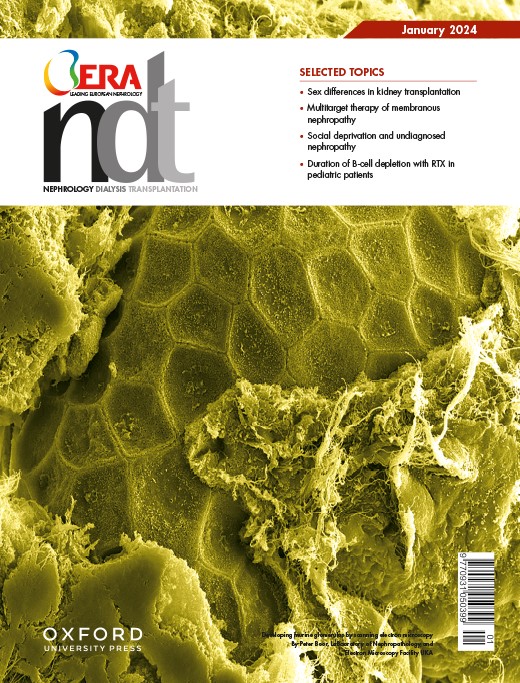在高免疫风险肾移植受者的早期方案活检中诊断出抗体介导的排斥反应
IF 4.8
2区 医学
Q1 TRANSPLANTATION
引用次数: 0
摘要
背景 肾移植受者体内存在供体特异性抗-HLA抗体,其发生抗体介导的排斥反应(AMR)的风险会增加。早期规范化肾活检可作为改善这类患者诊断的一种策略。方法 我们对2015年至2022年期间155例高度致敏的肾移植受者进行了评估,这些受者移植前cPRA等级为I+II> 90%。纳入了在移植后两周内进行协议活检的患者。结果 共有122名患者被纳入研究。其中13人(10.6%)在移植后两周内被诊断为极早期抗体介导的排斥反应(veABMR)。这相当于该人群随访期间报告的所有 ABMR 病例的 52%(13/25 例患者)。与早期方案活检中无排斥反应的患者相比,静脉ABMR患者一年和三年的移植物存活率明显较低(p &p;lt;0.001)。就严重程度而言,静脉ABMR队列的移植物失败危险比(HR)为10.33(95% CI 3.23-33.06;p &;lt;0.001)。移植当天出现供体特异性抗体(DSA)II级和较高比例的外胚层错配(EpMM),尤其是EpMM DQA1,与静脉ABMR的发生相关。结论 早期方案活检在高风险免疫患者早期发现 veABMR 方面起着关键作用。尽管排斥反应得到了早期治疗,但 veABMR 患者仍面临着移植物丢失的巨大风险。本文章由计算机程序翻译,如有差异,请以英文原文为准。
Antibody-mediated rejection diagnosed in early protocol biopsies in high immunological risk kidney transplant recipients
Background Renal transplant recipients with donor-specific anti-HLA antibodies are at an increased risk of antibody-mediated rejection (AMR). Early protocolized renal biopsies may serve as a strategy to improve diagnosis in this patient population. Methods We evaluated 155 highly sensitized renal transplant recipients with cPRA class I + II > 90% pre-transplant from 2015 to 2022. Patients with protocol biopsies within the first two weeks post-transplant were included. Results A total of 122 patients were included in the study. Of these, 13 (10.6%) were diagnosed with very early antibody-mediated rejection (veABMR) within the first two weeks post-transplant. This corresponds to 52% (13/25 patients) of all ABMR cases reported during the follow-up of this population. The graft survival rates at one and three years were significantly lower in patients with veABMR (p < 0.001) compared to patients without rejection in the early protocol biopsy. In terms of severity, the veABMR cohort exhibited a hazard ratio (HR) of 10.33 (95% CI 3.23–33.06; p < 0.001) for graft failure. The presence of donor-specific antibodies (DSA) class II on the day of transplantation and a higher percentage of eplet mismatch (EpMM), particularly EpMM DQA1, correlated with the development of veABMR. Conclusion Early protocol biopsies play a pivotal role in the early detection of veABMR in high-risk immunological patients. Patients with veABMR face significant risks of graft loss, despite early treatment of rejection.
求助全文
通过发布文献求助,成功后即可免费获取论文全文。
去求助
来源期刊

Nephrology Dialysis Transplantation
医学-泌尿学与肾脏学
CiteScore
10.10
自引率
4.90%
发文量
1431
审稿时长
1.7 months
期刊介绍:
Nephrology Dialysis Transplantation (ndt) is the leading nephrology journal in Europe and renowned worldwide, devoted to original clinical and laboratory research in nephrology, dialysis and transplantation. ndt is an official journal of the [ERA-EDTA](http://www.era-edta.org/) (European Renal Association-European Dialysis and Transplant Association). Published monthly, the journal provides an essential resource for researchers and clinicians throughout the world. All research articles in this journal have undergone peer review.
Print ISSN: 0931-0509.
 求助内容:
求助内容: 应助结果提醒方式:
应助结果提醒方式:


